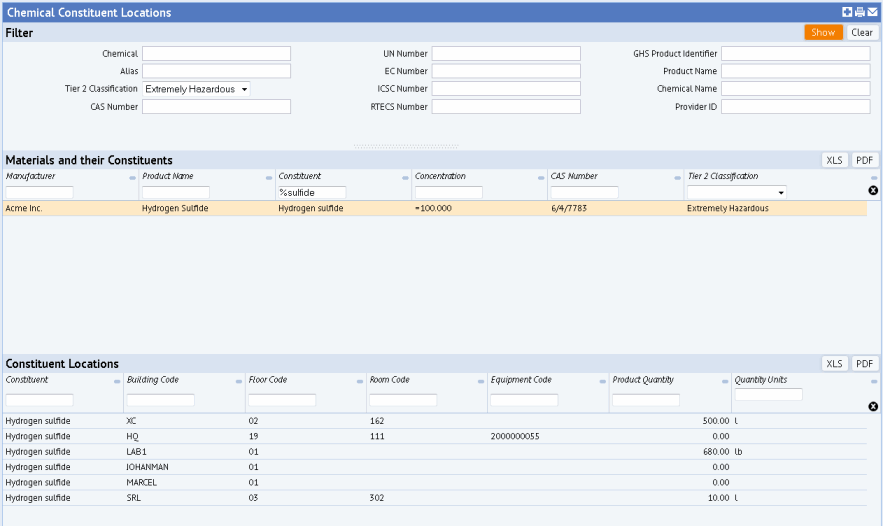Sustainability & Risk / Hazardous Materials / Review Material Inventory
Chemical Constituent Locations
The Chemical Constituent Locations report is designed to locate products that contain particular chemicals. For example your health and safety officer might impose a new rule for storage temperature of products containing a chemical. This report will allow you to find the locations for that constituent even if it is just a component of another product.
To generate this report, you must define chemicals using the Background Data - Hazmat / Define Chemicals task, and you must associate these chemicals with SDSs. See Define Materials and Safety Data Sheets (SDS) .
The Filter console at the top of the form provides a variety of search criterion. The table below define the search criteria. You can enter what you know, and then filter the results to get more specific.
For example you might know that the chemical has a Tier 2 classification of "Extremely Hazardous." In this case, you would:
- Use the Filter to so you would complete the Tier 2 Classification field in the filter with "Extremely Hazardous" and click Show.
- In the "Material and their Constituents" pane, you could use the Smart Search console and filter on Constituent names that contain sulfide to find sulfide- containing products.
- Select one of the sulfide-containing products, and the "Constituent Locations" grid will display all locations that have products that contain sulfide.
- Notice that if there are no values for certain fields (such as the subroom location fields or Equipment Code), the system hides these fields. If you change the filter to include records that have values for these fields, the view will again show these fields.
In addition to the constituent name and location information, this report also shows quantity and container information. Note that this data is the quantity and container associated with the product that contains the constituent and may not be representative of the actual quantity of the named constituent. For example, liquid floor cleaner contains the chemical "Linear Alkyl Benzene Sulfonic Acid, Sodium Salt," but more than half the volume of liquid floor cleaner is water. So, if you see the constituent "Linear Alkyl Benzene Sulfonic Acid, Sodium Salt" with a quantity of 32 oz in this report, there are 32 oz of liquid floor cleaner not 32 oz of "Linear Alkyl Benzene Sulfonic Acid, Sodium Salt". To assist in evaluating how much of a constituent is present, the concentration is displayed in the SDS grid.
The report also displays the temperature and pressure associated with the storage location.
To see all the details of a particular material, click on it and the system presents a pop-up form listing all of the details about this instance of the material.

| Field | Purpose |
|---|---|
| Chemical Constituent Filters | |
|
Chemical |
The name of the chemical. |
|
Alias |
Another name by which the chemical may be known. |
| Tier 2 Classification |
Hazard classification provided by the EPA. This classification determines if a product is a candidate for Tier I or Tier II Chemical Inventory reporting. Possible values are:
|
|
CAS Number |
CAS numbers are unique identifiers assigned by the Chemical Abstracts Service to chemicals including elements, isotopes, organic and inorganic compounds, organometallics, metals, nonstructurable materials. |
|
UN Number |
United Nations number. A four-digit number assigned to potentially hazardous products. UN numbers are used by emergency response personnel for identification of materials during transportation emergencies. UN numbers are internationally recognized. |
|
EC Number |
The European Commission number. It is a seven-digit code that is assigned to chemical substances that are commercially available within the European Union. |
| ICSC Number | International Chemical Safety Card identifier. These cards provide essential health and safety information and often form part of education and training activities. ICSCs may also be used by agencies responding to chemical incidents. Information in an ICSC is peer-reviewed by the World Health Organization. |
|
RTECS Number |
The Registry of Toxic Effects of Chemical Substances identifier assigned by US National Institute of Occupational Safety and Health (NIOSH) to every chemical in the RTECS database. The identifier is a nine-character sequence of which the first two are alphabetic with the remainder numeric. |
|
SDS Filters |
|
| GHS Product Identifier | Globally Harmonized System Identifier |
| Product Name | The name of the product |
| Chemical Name | Chemical name of the product. |
| Manufacturer | Name of the Manufacturer. |